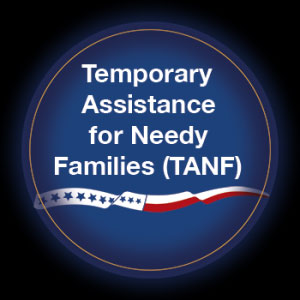One of the ways our government provides a safety net for those less fortunate is through a program called Temporary Assistance for Needy Families, or TANF. TANF was enacted in 1996 as a program that replaced Aid to Families with Dependent Children (AFDC), which used to provide cash assistance to families with children experiencing poverty. Under TANF, the federal government provides a block grant to the states, which then use these funds to run their own programs. To receive federal funds, states must also spend some of their own dollars on those programs and face severe fiscal penalties if they fail to do so. This state-spending requirement, known as the “maintenance of effort” (MOE) requirement, replaced the state match that AFDC required.
States can use federal TANF and state MOE dollars to meet any of the four goals set out in the 1996 law: (1) assisting needy families so children can be cared for in their own homes or the homes of relatives; (2) reducing the dependency of needy parents by promoting job preparation, work, and marriage; (3) preventing pregnancies among unmarried persons; and (4) encouraging the formation and maintenance of two-parent families.
These goals are broad, giving states lots of freedom to use these federal dollars in a way that they think brings about positive outcomes.
So what have we done with the federal TANF money?
We’ve let it pile up unused.
ProPublica, a nonprofit newsroom that investigates abuses of power, recently published an unflattering article that calls out several states for doing nothing at all with large sums of money. It reports: “According to recently released federal data, states are sitting on $5.2 billion in unspent funds from the federal Temporary Assistance for Needy Families program, or TANF. Nearly $700 million was added to the total during the 2019 and 2020 fiscal years, with Hawaii, Tennessee and Maine hoarding the most cash per person living at or below the federal poverty line.”

Source: U.S. Department of Health and Human Services
As this graph shows, the “unobligated balance” of the federal block grants, meaning federally authorized money that we haven’t spent, has been rising steadily over the last five fiscal years. In federal fiscal year 2020 (the year starting Oct. 1, 2019, and ending Sept. 30, 2020), our unobligated balance was $364 million, equivalent to almost $3,000 per person living in poverty.
Certainly, we have been using part of the TANF money. But we have been spending quite a bit of our own funds:

According to ProPublica, a Hawaii state spokesperson said that our state government plans to use its surplus to extend employment services like job coaching and placement for noncustodial parents who have children receiving TANF and to provide diaper assistance to families that are eligible for the program. The state is also considering increasing benefits and offering monthly housing assistance.
The question, however, is why has it taken so long for our bureaucrats to come up with ways to put that money to good use? It certainly won’t help alleviate poverty if it’s sitting in some bank somewhere.
Legislators and other interested people: Here’s your chance. The Legislature is now grilling each of the Executive Branch departments for answers on how they plan to spend your hard-earned dollars. It’s a great time to ask the Department of Human Services what the heck is going on with their steadily growing wad of unused TANF cash.

